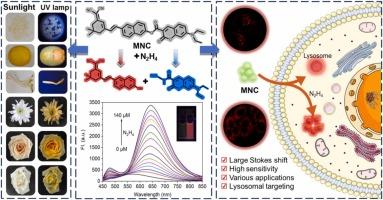Application of a fluorescent probe exhibiting a large stokes shift after the precise detection of hydrazine in plants, foods and living cells
IF 12.2
1区 环境科学与生态学
Q1 ENGINEERING, ENVIRONMENTAL
引用次数: 0
Abstract
As a strongly reducing agent and highly reactive alkaline substance, hydrazine is widely used in various industrial productions. Excessive hydrazine may pose a significant risk to the environment and human health. Here, a new fluorescent probe, (E)-6-(2-(3-(dicyanomethylene)-5,5-dimethylcyclohex-1-en-1-yl)vinyl) naphthalen-2-yl-7-(diethylamino)-2-oxo-2H-chromene-3-carboxylate (abbreviated as MNC) for detecting hydrazine in environmental and biological samples was introduced. The probe not only shows a good photostability, a turn-on red fluorescent response with a low detection limit (0.40 μM), but also exhibits a large Stokes shift (215 nm) after reacting with hydrazine. In practical applications, this probe has been effectively used for the detection of hydrazine in environmental, plant, and food samples. It has also been applied to identify the presence of hydrazine in the roots of Arabidopsis thaliana, as well as in zebrafish and living cells. This research introduces a potent and versatile tool for the environmental and biological monitoring of hydrazine.

求助全文
约1分钟内获得全文
求助全文
来源期刊

Journal of Hazardous Materials
工程技术-工程:环境
CiteScore
25.40
自引率
5.90%
发文量
3059
审稿时长
58 days
期刊介绍:
The Journal of Hazardous Materials serves as a global platform for promoting cutting-edge research in the field of Environmental Science and Engineering. Our publication features a wide range of articles, including full-length research papers, review articles, and perspectives, with the aim of enhancing our understanding of the dangers and risks associated with various materials concerning public health and the environment. It is important to note that the term "environmental contaminants" refers specifically to substances that pose hazardous effects through contamination, while excluding those that do not have such impacts on the environment or human health. Moreover, we emphasize the distinction between wastes and hazardous materials in order to provide further clarity on the scope of the journal. We have a keen interest in exploring specific compounds and microbial agents that have adverse effects on the environment.
 求助内容:
求助内容: 应助结果提醒方式:
应助结果提醒方式:


